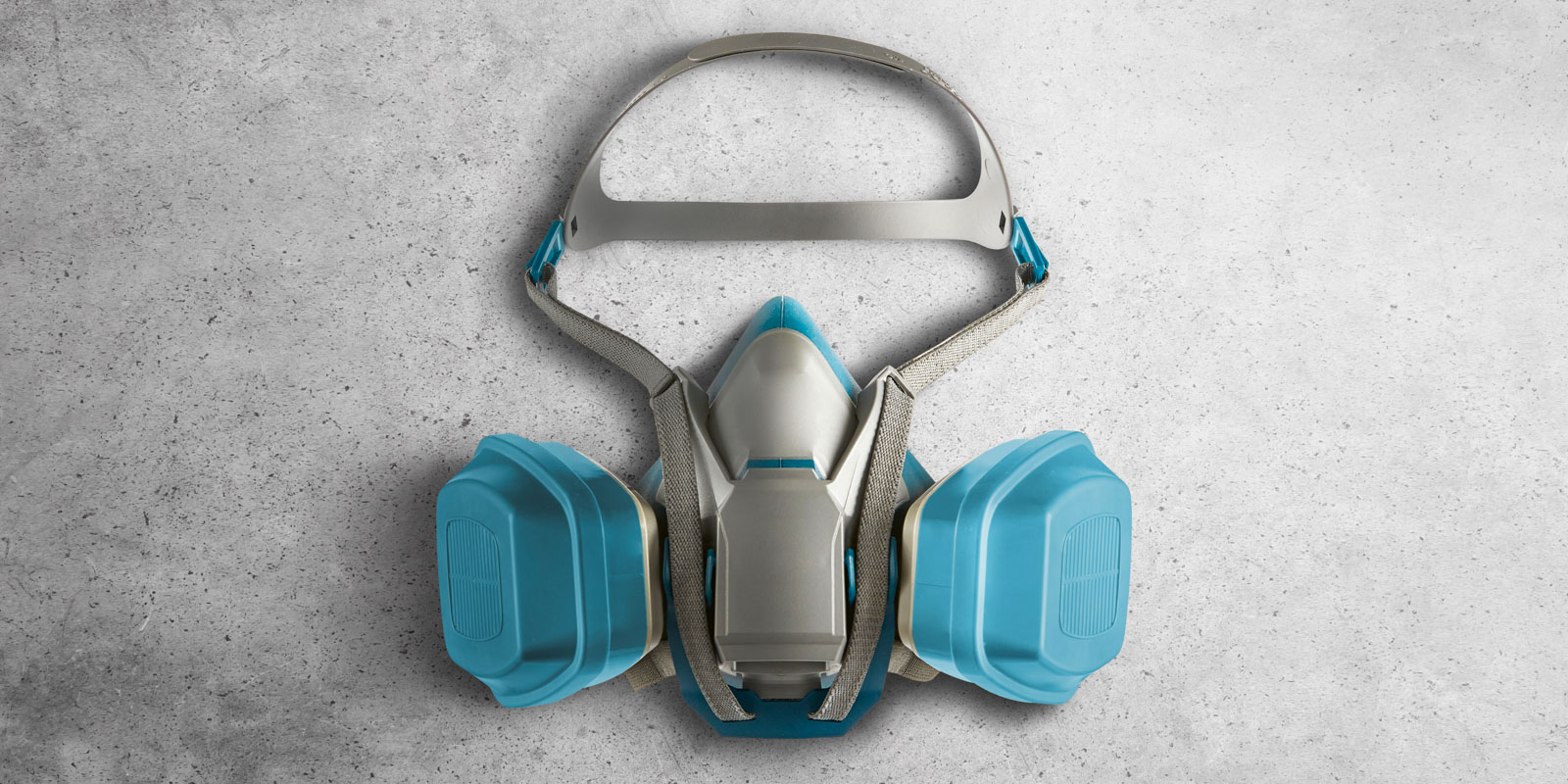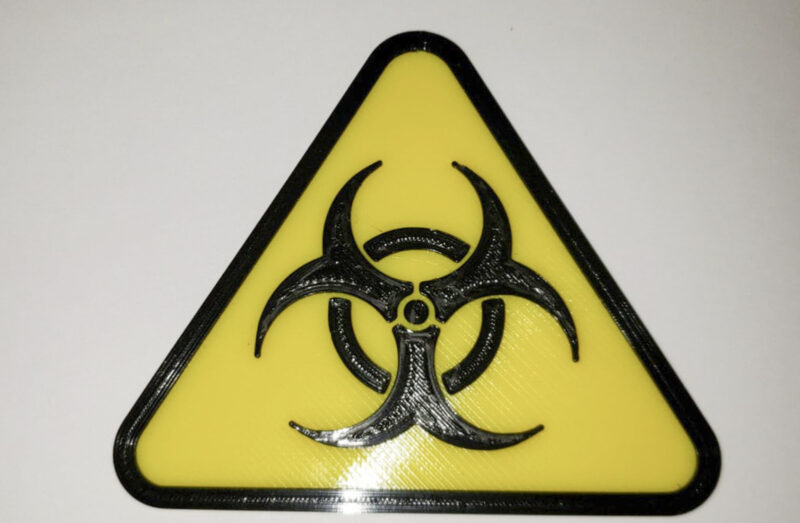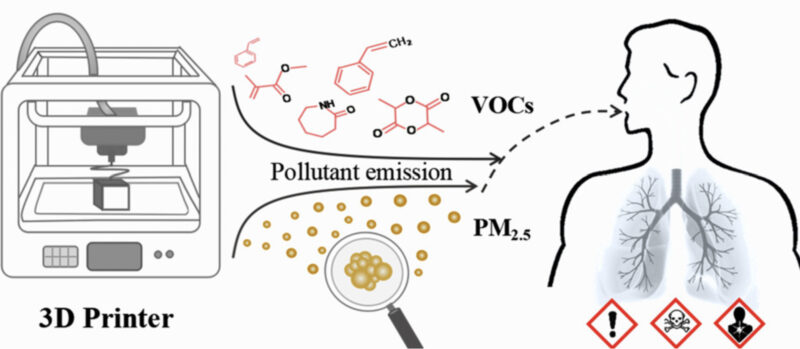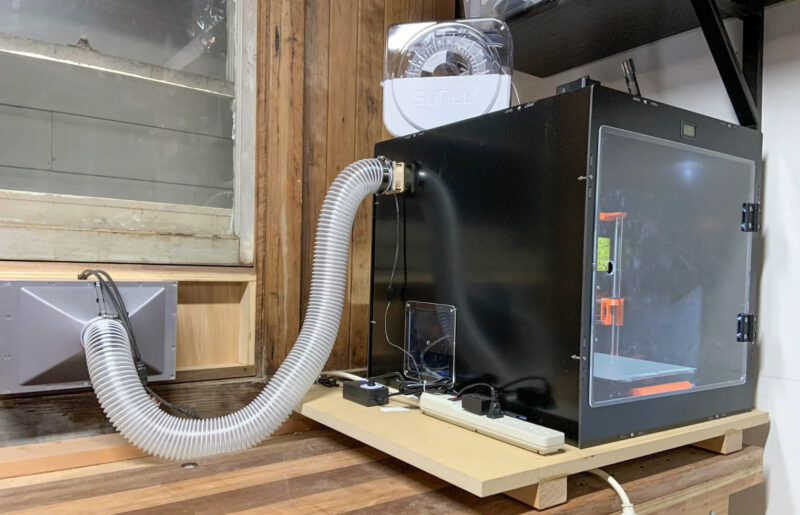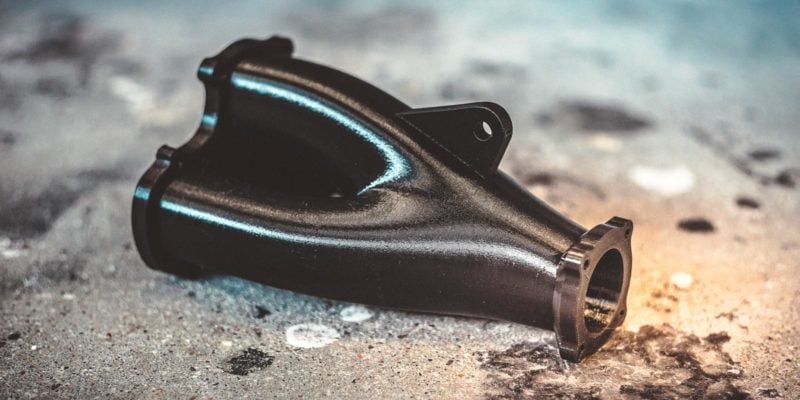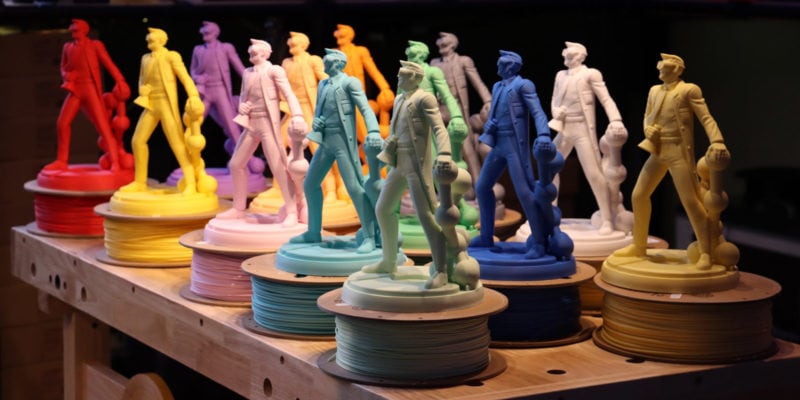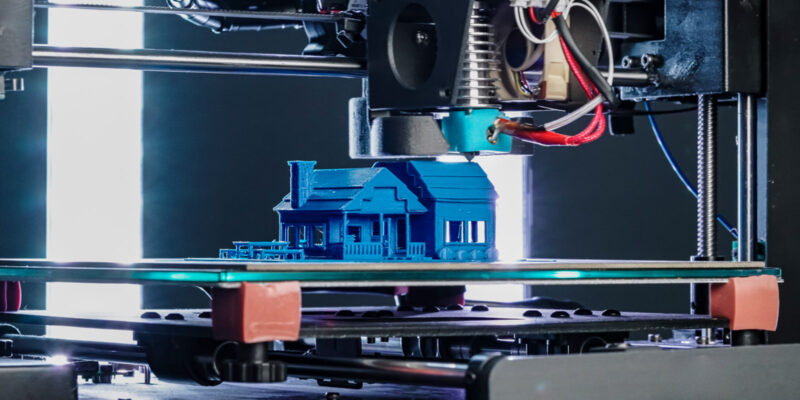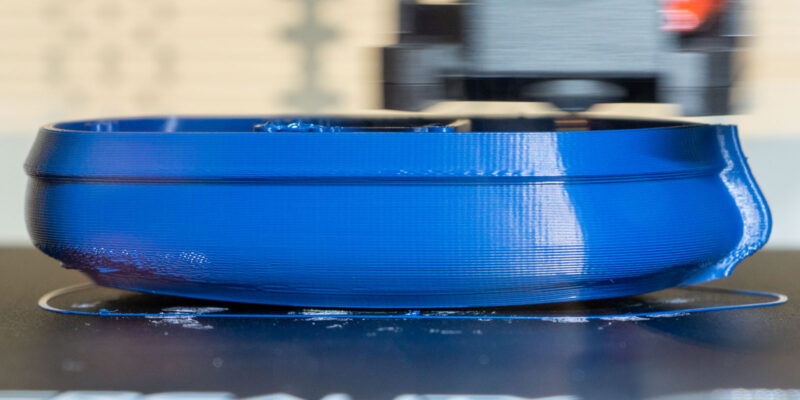When it comes to 3D printing filaments, ABS isn’t typically the crowd favorite. While ABS filament is affordable and yields much more durable parts compared to PLA, the material is noticeably more difficult to print. Even more critical are its toxicity and safety concerns.
Unlike PLA filament, which is sourced from corn starch, ABS is a petroleum-based plastic that is developed through many unnatural processes. If you smell it during 3D printing, you’ll quickly identify its chemical odor. With this in mind, it’s no surprise that people assume that ABS is a toxic, harmful plastic to use.
Technically, ABS isn’t a toxic material when solid. ABS filament only becomes dangerous when 3D printed as the material releases fumes when melted. However, it’s worth noting that the actual risk of any health complications is pretty low, especially if you use an enclosure and ventilate your printing space.
In this article, we’ll explain the health and safety concerns associated with ABS 3D printing filament and give you safety tips on proper ventilation. Enjoy and stay safe!
Where Do the Safety Concerns of 3D Printing ABS Come From?

Acrylonitrile Butadiene Styrene, or ABS, is one of the most prevalent plastics in the world. You can find it in everyday items like hard hats, LEGO bricks, and even vacuum cleaners. So what has thousands of 3D printing enthusiasts concerned about this material?
The main reason for concern is the dangerous fumes released when melting ABS filament, an essential part of the 3D printing process.
Over the past two decades, multiple studies have highlighted the true danger of ABS fumes, pointing out the risk of volatile organic compounds (VOCs) and ultrafine particles (UFPs), which we’ll talk more about later.
Aside from the ABS fumes, another safety concern is the plastic’s rather unnatural origins.
While some plastics, like PLA, are made from processed plant fibers, ABS is sourced from petroleum. Once the petroleum is extracted, polymerization and a handful of other complex scientific processes are required to make the final plastic material.
As such, many people worry about the environmental and health consequences of using ABS plastic when 3D printing. Whether PLA is food safe is a popular question, so you can imagine that ABS raises even more questions.
What Fumes Does ABS Release?
Melting ABS plastic releases all sorts of particles and fumes during 3D printing, but the two important ones to watch out for are VOCs and UFPs. There’s no way to prevent these particles, and even the best ABS filament emits them.
VOCs
Volatile organic compounds, or VOCs, are chemicals that evaporate into the air at room temperature. You’ve probably dealt with VOCs before when you’ve used paint or nail polish remover, as studies show that these products release a lot of harmful VOCs when exposed to open air.
While not all VOCs are super dangerous, some of the compounds released when printing ABS can be very harmful.
Official studies have found that printing ABS filaments can release VOCs containing acrylonitrile, a known carcinogen. Acrylonitrile fumes typically create that pungent odor when printing ABS. Inhaling them can cause a plethora of health issues like nausea, dizziness, and respiratory problems.
UFPs
The other type of particle released when printing ABS is ultrafine particles or UFPs. UFPs are minuscule solid bits or liquid droplets, usually less than 100 nanometers in diameter, that linger in the air.
UFPs can enter the air in a few ways, such as when the filament flows out the nozzle, as the ABS plastic cools, or even as a by-product of VOCs evaporating.
UFPs are basically impossible to avoid when printing ABS. Once in the air, they can enter your bloodstream or penetrate your respiratory system, causing breathing issues and potentially even cardiovascular and neurological problems.
At What Temperature Does ABS Give Off Fumes?
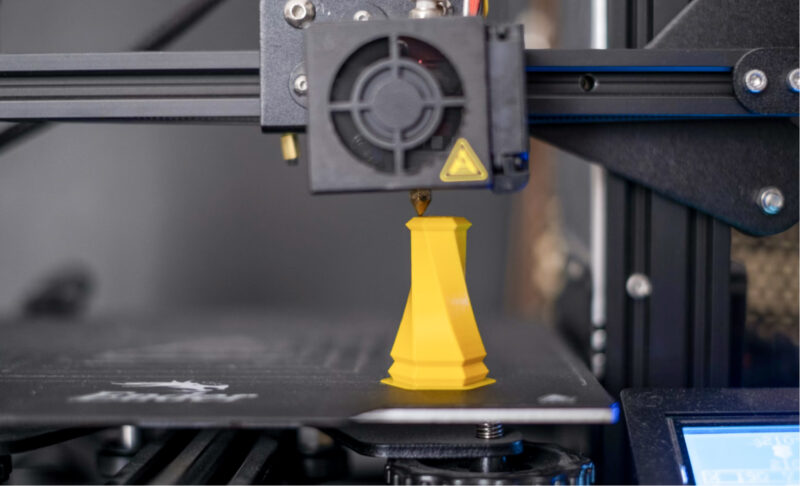
In its solid form, ABS plastic is safe and doesn’t release any fumes. Only when the material is heated to a specific temperature does it release dangerous fumes.
This typically happens when ABS reaches the temperature at which it gets soft. This solid-to-liquid transition starts at what’s known as the glass transition temperature. If you are familiar with 3D printing, this is often a similar temperature to what the heated bed is set to.
According to material science research, the glass transition temperature of ABS filament is about 105 °C. As such, you won’t be able to realistically 3D print ABS at a low enough temperature to avoid releasing fumes.
It’s also important to note the impact of printing temperature on the volume of fume emissions for ABS. According to a detailed study of fume emission among FDM filament materials, higher nozzle temperatures lead to noticeably higher volumes of fumes.
In other words, printing ABS with a nozzle temperature of 260 °C will release a much higher volume of fumes than a temperature of 230 °C.
That doesn’t mean you should drastically reduce your ABS printing temperatures, however. This would reduce your print quality and lead to disappointing results. Instead, you are better off following one of the other measures listed below to print ABS with minimal health risks.
Potential Side Effects of Exposure to 3D Printing Fumes
While you won’t be coughing ten seconds after you use ABS, research suggests that prolonged exposure to 3D printing fumes can cause a number of side effects, such as:
- Headaches
- Nausea
- Dizziness
- Eye irritation
- Physical discomfort
- Nose and throat irritation
- Respiratory issues
- Cardiovascular issues
- Neurological issues
- Cancer
If you smell something when printing with ABS material, chances are you’ve already inhaled these fumes. But, don’t fret. Most of the time, only prolonged exposure will cause any of these potential side effects.
This is why minimizing respiratory exposure to ABS printing fumes is critical for long-term health. A 3D printer enclosure, filtration system, and/or air purifier go a long way in reducing long-term exposure. A simpler solution would be an off-the-shelf enclosed 3D printer with HEPA filter.
Is It Safe to Print ABS Indoors Without an Enclosure?
Generally, it is considered a health hazard to print ABS without an enclosure. There’s no way around it, your 3D printer exudes fumes when printing with ABS. Printing indoors without a good ventilation system creates an inhalation hazard that you are better off avoiding.
One study from the Health Hazard Evaluation Program shows that 3D printing ABS without an enclosure allows a high volume of harmful ABS fumes to build up in your living space. As we’ve mentioned, these fumes can cause significant health problems, especially after prolonged exposure.
Additionally, it’s worth noting that ABS is very sensitive to changes in temperature. Printing the material without an enclosure is likely to lead to low-quality prints anyway.
While there are ways to reduce ABS warping and curling, there are also plenty of alternatives to ABS that you can opt for.
What About With an Enclosure?
If you’re considering printing indoors with ABS, we highly recommend using an enclosure. Enclosures not only improve the quality of prints by trapping heat around the 3D printer, but they also trap the fumes produced when printing ABS.
Of course, trapping the fumes won’t eliminate them. It will contain them, however, greatly limiting your exposure to these harmful particles.
But, if you want to further ensure a safe living space, you can add some form of external ventilation to your 3D printer’s enclosure. To be even more safe, it’s a good idea to not keep your 3D printer in your living or sleeping quarters. A garage or shed would work better, provided that you can still monitor the machine.
How to Properly Ventilate When 3D Printing ABS
If you want to ventilate your 3D printer to minimize the fumes you are exposed to, the first step is to enclose your 3D printer.
You’ll want to make sure the enclosure is relatively sealed. Of course, it will never be airtight. But that’s okay if the extraction fan you use in the enclosure is powerful enough and creates sufficient negative pressure.
From there, connect a ventilation tube to the fan in the enclosure. Connect the other end to a hole in a sealed window or wall, and that’s pretty much all there is to it. The fan now extracts ABS fumes from the enclosure to the outside while 3D printing, giving you fresh air in the same room as the 3D printer.
Is ABS Toxic When Burned?
Yes! ABS is already very dangerous when simply melted, but it becomes more toxic if you heat it far past its recommended temperature, or even burn it.
Furthermore, burning ABS plastic releases a number of additional harmful printer fumes, including carbon monoxide, nitrogen dioxide, and hydrogen cyanide. All of these chemicals can be fatal in large amounts, so it’s very important that you never burn ABS.
How Does Its Toxicity Compare to Other Filaments?
While ABS gets the most attention for its fumes, technically, every filament material (even PLA) releases VOCs and UFPs when melted.
However, according to the EPA, different materials release different levels and types of VOCs and UFPs. Compared to the other widely-used filament materials, ABS takes the cake as the most dangerous to your health. This is partly due to the material’s use of the carcinogen acrylonitrile.
The only exception to this is polycarbonate (PC) filament, which is considered even more dangerous than ABS. That’s because PC filament not only contains acrylonitrile, but this type of filament also releases other toxic fumes, such as Bisphenol A (BPA) and Phthalates.
Other filament materials, like PLA, PETG, and TPU, are much more safe to use compared to ABS, and produce smaller amounts of harmful fumes.
Is ABS Filament Body Safe?
In its solid form, ABS poses no significant threat to your health or body through physical contact. In this state, the chances of VOCs, UFPs, or carcinogens entering your body through your skin are next to none.
Of course, there’s always some risk when it comes to long-term exposure. To be on the safe side, it’s a good idea to avoid long direct bodily contact with ABS plastic. If you’re 3D printing a watch chain or necklace, consider sealing it with clear epoxy before wearing it.
Is ABS Plastic Food Safe?
ABS plastic is generally not considered food-safe, as the material is known to contain Bisphenol A (BPA). For reference, BPA is a class of endocrine disruptor chemicals. This means it interferes with your body’s hormones, which is obviously very dangerous.
As such, it’s highly important that you remember to not use ABS filament to print any model that will contact food or liquid.
However, because of the nature of fused filament fabrication, no 3D-printed object is truly food-safe. Not only are there contaminants from the 3D printer to deal with, but you’ll also find that the gaps between layers are an excellent breeding ground for bacteria.
In short, you’ll want to seal any 3D-printed item for food with a food-grade epoxy. Only then it is safe for your kitchen or dinner table.
What Are the Environmental Concerns?
ABS filament is far from environmentally friendly. As we mentioned, ABS is derived from petroleum, which is sourced from drilling deep into the Earth. Extracting crude oil can harm the environment through water pollution, the emission of greenhouse gasses, and more.
On top of the environmental issues with extracting crude oil, the additional processes that turn petroleum into ABS plastic, such as polymerization, can also hurt the environment.
And, once the ABS plastic is created, there’s essentially no recycling process. ABS plastic is not biodegradable, meaning ABS 3D prints can’t naturally degrade or decompose over time.
The only way to ensure the safe and eco-friendly disposal of ABS plastic is to send the waste plastic to special facilities, a cost most filament manufacturers opt out of.
So, if you’re keen on doing your part to save the planet, you might want to consider using a more eco-friendly filament material, like PLA or PETG.
Conclusion: Is ABS Toxic Enough to Avoid When 3D Printing?
You should always be cautious when 3D printing ABS plastic. ABS filament, though an affordable and durable filament option, presents a lot of health hazards that should not be overlooked.
First off, printing with ABS plastic can release VOCs, including carcinogens, that can negatively impact your health. Additionally, UFPs tend to spew into the air and can also hurt you in the long run.
As such, if you’re 3D printing with ABS, make sure to enclose your printer and use a ventilation system to ensure you aren’t inhaling the toxic and hazardous fumes released by this material.
